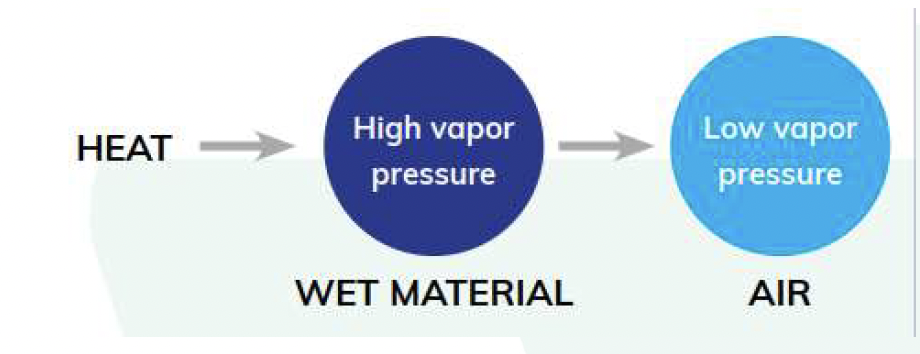What Are Vapor Pressure Differentials and How to Use to Speed up Evaporation

What Are Vapor Pressure Differentials and How to Use to Speed up Evaporation


Meet Ed
Instructor Ed Jones has over 30 years of experience in theindustry, has the title of MasterWater Restorer, is an Institute ofInspection Cleaning andRestoration Certification (IICRC)-approved instructor, and hasserved on the S500-2021consensus body committee todevelop the most recent standard.
Water vapor molecules in a given space are repelling each other, creating a pressure that can be measured by what we call vapor pressure. The more water vapor molecules in that space, the more vapor pressure. Vapor pressure seeks equilibrium, so high pressure moves to low pressure.
Water in liquid form also has a vapor pressure. When we provide energy in the form of heat to the water (like when boiling water on a stove), it increases the vapor pressure of the water, causing it to evaporate more quickly. When comparing the vapor pressure of the water vapor in the air (VPa) to the vapor pressure of the water in a material (VPw), we want low vapor pressure air (caused by dehumidifying the air when utilizing mechanical dehumidifiication) while raising the vapor pressure of the water in the materials (adding energy in the form of heat to the wet materials), thus creating a vapor pressure differential. The bigger the vapor pressure differential, the quicker the water evaporates from the material.
If drying is not progressing properly add heat to the wet surface to raise the vapor pressure of the material while lowering the vapor pressure of the air next to the material by dehumidifying the air. This process will greatly speed up the drying process and in class 4 situations help move moisture in the core of the material to the surface using vapor diffusion.

Always place containment to separate the affected area from the unaffected areas and to focus your drying on the smallest area possible, thus making it easier to raise ambient air temperatures. If you are drying in a large area, e.g., open floor plan with vaulted ceilings drying hardwood flooring, place your containment just above the wet flooring and duct heated airflow from your dehumidifier or from your portable heater, or both, under your tented containment allowing the hot, dry air to flow across the surface of the wet material exhausting out the other side of your tent. In our Ohio IICRC approved ASD flood house, we use R10 rated fiberboard to contain our class 4 chamber to assist with raising temperatures (20+ degrees inside the drying chamber). We try to stay below 105 degrees F ambient air and wet surface temperatures. Always, take photos of your infrared thermometer to prove your use of heat to speed up drying.
Heat it Up, to Speed it Up!
Jeremy Reets, an IICRC approved instructor, developed an Evaporation Potential Chart to make it easy to determine good vapor pressure differentials or what he calls Evaporation Potential. You want to be in the yellow or green on the below chart to provide a good evaporation potential that will speed up evaporation.






